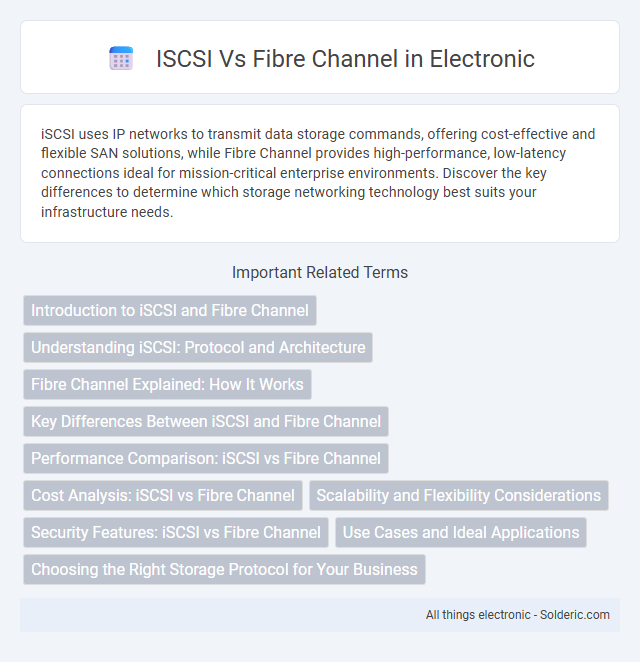iSCSI uses IP networks to transmit data storage commands, offering cost-effective and flexible SAN solutions, while Fibre Channel provides high-performance, low-latency connections ideal for mission-critical enterprise environments. Discover the key differences to determine which storage networking technology best suits your infrastructure needs.
Comparison Table
| Feature | iSCSI | Fibre Channel |
|---|---|---|
| Technology | IP-based storage networking protocol | High-speed dedicated storage network protocol |
| Transport Medium | Ethernet | Fiber optic cables |
| Speed | 1 Gbps to 100 Gbps | 8 Gbps to 128 Gbps |
| Latency | Higher latency due to TCP/IP overhead | Low latency, optimized for storage |
| Cost | Lower cost, uses existing Ethernet infrastructure | Higher cost, requires specialized hardware |
| Complexity | Easier to deploy and manage | More complex configuration and management |
| Distance Support | Up to 100 km with IP networks | Typically up to 10 km, extendable with directors |
| Use Case | SMBs, IP storage, cost-sensitive environments | Enterprise data centers requiring high performance |
Introduction to iSCSI and Fibre Channel
iSCSI (Internet Small Computer Systems Interface) enables storage data transfer over standard Ethernet networks, offering cost-effective and scalable SAN solutions ideal for small to medium businesses. Fibre Channel provides high-speed, low-latency connectivity designed for enterprise data centers requiring robust, dedicated storage networks with dedicated Fibre Channel switches. Your choice between iSCSI and Fibre Channel impacts performance, infrastructure complexity, and budget considerations in storage area networks.
Understanding iSCSI: Protocol and Architecture
iSCSI (Internet Small Computer Systems Interface) uses the TCP/IP protocol suite to transport SCSI commands over Ethernet networks, enabling cost-effective and flexible storage area network (SAN) deployments. Its architecture encapsulates SCSI commands into IP packets, allowing storage devices to be accessed remotely as if they were locally attached, which simplifies network management and leverages existing Ethernet infrastructure. You benefit from iSCSI's compatibility with standard network hardware, making it ideal for organizations seeking scalable and easily deployable SAN solutions without investing in specialized Fibre Channel equipment.
Fibre Channel Explained: How It Works
Fibre Channel operates as a high-speed network technology designed specifically for storage area networks (SANs), using fiber optic cables to transmit data at rates up to 128 Gbps. It relies on a switched fabric topology that enables multiple devices to communicate simultaneously with low latency and high reliability. Fibre Channel encapsulates SCSI commands within its protocol, ensuring fast and efficient access to block-level storage over dedicated hardware, making it ideal for enterprise data centers demanding high performance and scalability.
Key Differences Between iSCSI and Fibre Channel
iSCSI uses standard Ethernet networks to transmit SCSI commands, enabling cost-effective and flexible storage area network (SAN) implementations, while Fibre Channel relies on specialized high-speed fiber optic cables for low-latency, high-performance data transfer. Fibre Channel typically offers higher throughput and lower latency compared to iSCSI, making it ideal for mission-critical applications requiring consistent speed and reliability. Your choice between iSCSI and Fibre Channel depends on factors like budget, existing infrastructure, scalability needs, and performance requirements.
Performance Comparison: iSCSI vs Fibre Channel
Fibre Channel consistently delivers higher throughput and lower latency compared to iSCSI, making it the preferred choice for mission-critical applications requiring rapid data access. iSCSI leverages standard Ethernet infrastructure, offering cost-effective scalability but generally exhibits higher CPU overhead and network latency. Performance benchmarks show Fibre Channel achieving up to 16 Gbps or more, whereas iSCSI typically operates at 10 Gbps or lower, impacting overall storage network efficiency.
Cost Analysis: iSCSI vs Fibre Channel
iSCSI offers a cost-effective solution by utilizing existing Ethernet infrastructure, reducing hardware expenses and simplifying deployment compared to Fibre Channel's specialized switches and host bus adapters. Fibre Channel incurs higher upfront costs due to dedicated networking components and maintenance but delivers lower latency and increased reliability for mission-critical storage environments. Total cost of ownership for iSCSI remains lower in small to medium businesses, while large enterprises may justify Fibre Channel's premium for performance and scalability.
Scalability and Flexibility Considerations
iSCSI offers greater scalability and flexibility due to its ability to run over existing Ethernet networks, allowing easy expansion without additional specialized hardware. Fibre Channel provides high performance and low latency but requires dedicated infrastructure, which can limit rapid scalability and increase costs. Your choice depends on whether you prioritize flexible, cost-effective growth (iSCSI) or consistent high-speed performance with specialized infrastructure (Fibre Channel).
Security Features: iSCSI vs Fibre Channel
iSCSI security relies heavily on IP network protocols, utilizing CHAP authentication, IPsec encryption, and VLAN segmentation to protect data in transit over Ethernet networks. Fibre Channel offers robust native security features such as zoning, LUN masking, and fabric-level authentication through Fibre Channel Security Protocol (FC-SP), providing granular access control and intrafabric encryption. Enterprises often choose Fibre Channel for environments requiring high security and low latency, while iSCSI leverages existing IP infrastructure with flexible security enhancements suitable for cost-effective deployments.
Use Cases and Ideal Applications
iSCSI is ideal for small to medium-sized businesses requiring cost-effective, flexible storage solutions over existing Ethernet networks, commonly used in virtualized environments and disaster recovery setups. Fibre Channel excels in large enterprises demanding high-performance, low-latency storage area networks (SANs) for mission-critical applications like databases and real-time analytics. Both technologies support storage consolidation, but Fibre Channel is favored for environments prioritizing throughput and reliability at scale.
Choosing the Right Storage Protocol for Your Business
iSCSI and Fibre Channel represent two leading storage protocols, each offering distinct advantages for data center environments. iSCSI leverages standard Ethernet networks, making it a cost-effective and flexible choice ideal for small to medium-sized businesses seeking easy scalability. Fibre Channel delivers high-speed, low-latency connectivity tailored for enterprises requiring maximum performance and reliability in mission-critical applications.
iSCSI vs Fibre Channel Infographic

 solderic.com
solderic.com